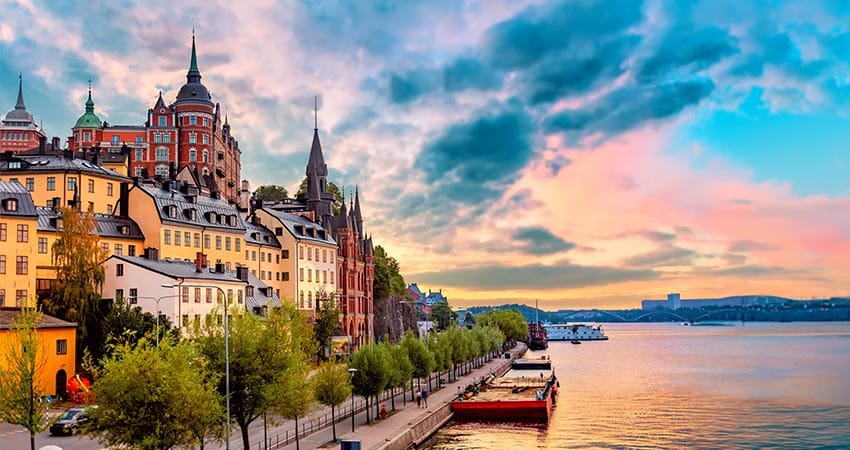Touring Scandinavia reveals a world of breathtaking landscapes, charming cities, and timeless traditions. Whether you explore Norway, Sweden, Denmark, Finland, or Iceland, each country offers something extraordinary—from Norway’s majestic fjords to Iceland’s steaming geysers.
Here are ten of the best Scandinavian experiences to inspire your next adventure.
1. Chase the Northern Lights
Between September and April, the skies over Norway, Finland, and Iceland shimmer with the ethereal glow of the Northern Lights. In Lapland, local lodges and glass igloos offer cozy vantage points, while guided excursions take you deep into dark, open landscapes for optimal viewing. Whether you drive yourself or travel with a local expert, witnessing the Aurora Borealis is truly magical.
2. Walk Through History at Bryggen, Norway
Wander the colorful wooden wharf of Bryggen in Bergen, a UNESCO World Heritage Site that once thrived as part of the Hanseatic trading empire. The narrow alleyways, shops, and cafés reveal centuries of craftsmanship and maritime life. Stroll on your own or join a walking tour to uncover the stories behind one of Europe’s oldest port cities.
3. Discover the Viking Legacy
Step into the Viking Age at museums and heritage centers across Scandinavia. See longships at Oslo’s Viking Ship Museum, visit the Viking Village in Iceland, or explore Denmark’s Roskilde Fjord, where you can sail in a replica longship.
4. Wander Stockholm’s Old Town
Gamla Stan, Stockholm’s medieval heart, is a maze of cobblestone streets and golden façades. Visit Storkyrkan Cathedral, the Royal Palace, and charming cafés where locals enjoy fika—coffee and pastries shared with friends. It is easy to explore independently, or you can take a guided city walk that brings Sweden’s royal and maritime stories to life.
5. Walk the Roof of Oslo’s Opera House
In the heart of Oslo, Norway’s Opera House invites you to walk on its marble roof for panoramic views of the fjord and mountains. It is a perfect stop on a scenic city stroll or a guided art and architecture tour. Combine it with a visit to the MUNCH Museum or a ferry ride through the Oslo Fjord for a blend of culture and nature.
6. Explore Vatnajökull Glacier, Iceland
Covering nearly 8 percent of Iceland, Vatnajökull Glacier is Europe’s largest. Take a guided glacier walk, cruise across the Jökulsárlón lagoon, or simply enjoy the sweeping views from your rental car along the Ring Road. This region is a highlight on both guided Iceland adventures and independent self-drives.
7. Experience Downtown Reykjavik
Compact, colorful, and creative, Reykjavik is a perfect base for exploring Iceland. Stroll its lively streets, sample Nordic cuisine, and browse local design shops. Travelers can enjoy the city independently or as part of a guided trip with day excursions to the Golden Circle, Blue Lagoon, or nearby volcanoes. Reykjavik blends modern culture with raw Icelandic nature.
8. Discover Zealand, Denmark
Home to Copenhagen, Denmark’s island of Zealand combines royal history with coastal charm. Visit Frederiksborg and Kronborg Castles, explore artist Thomas Dambo’s hidden giant trolls, or sail on Roskilde Fjord. Zealand delivers rich history, local cuisine, and relaxed Danish hospitality.
9. Visit Santa Claus Village, Lapland, Finland
In Rovaniemi, just above the Arctic Circle, Santa Claus Village is a favorite for travelers of all ages. Meet Santa, enjoy a reindeer or husky sleigh ride, and explore Nordic crafts under twinkling lights. You can reach Lapland by scenic train, guided coach tour, or rental car. In winter, snow and the Northern Lights make it especially magical; in summer, the Midnight Sun gives it a warm glow of its own.
10. Journey Through the Snaefellsnes Peninsula
From reindeer camps in the Arctic Circle to coastal cycling in Denmark, Scandinavia offers a mix of natural beauty, cultural heritage, and modern comfort. Whether you prefer a small guided vacation or a custom itinerary designed around your pace, Authentic Vacations will help you experience Scandinavia your way, with expert planning, local insight, and no hidden costs.
From reindeer camps in the Arctic Circle to coastal cycling in Denmark, Scandinavia offers adventures for every traveler, cultural, scenic, and spirit-lifting. With Authentic Vacations, your small guided tour includes local experts, curated activities, and transparent pricing so you can simply enjoy the journey.
When you’re ready for a Scandinavian vacation, let your Destination Expert know if you have any special interests. They’ll work to make your dreams a reality.
 My Trips
My Trips 


















